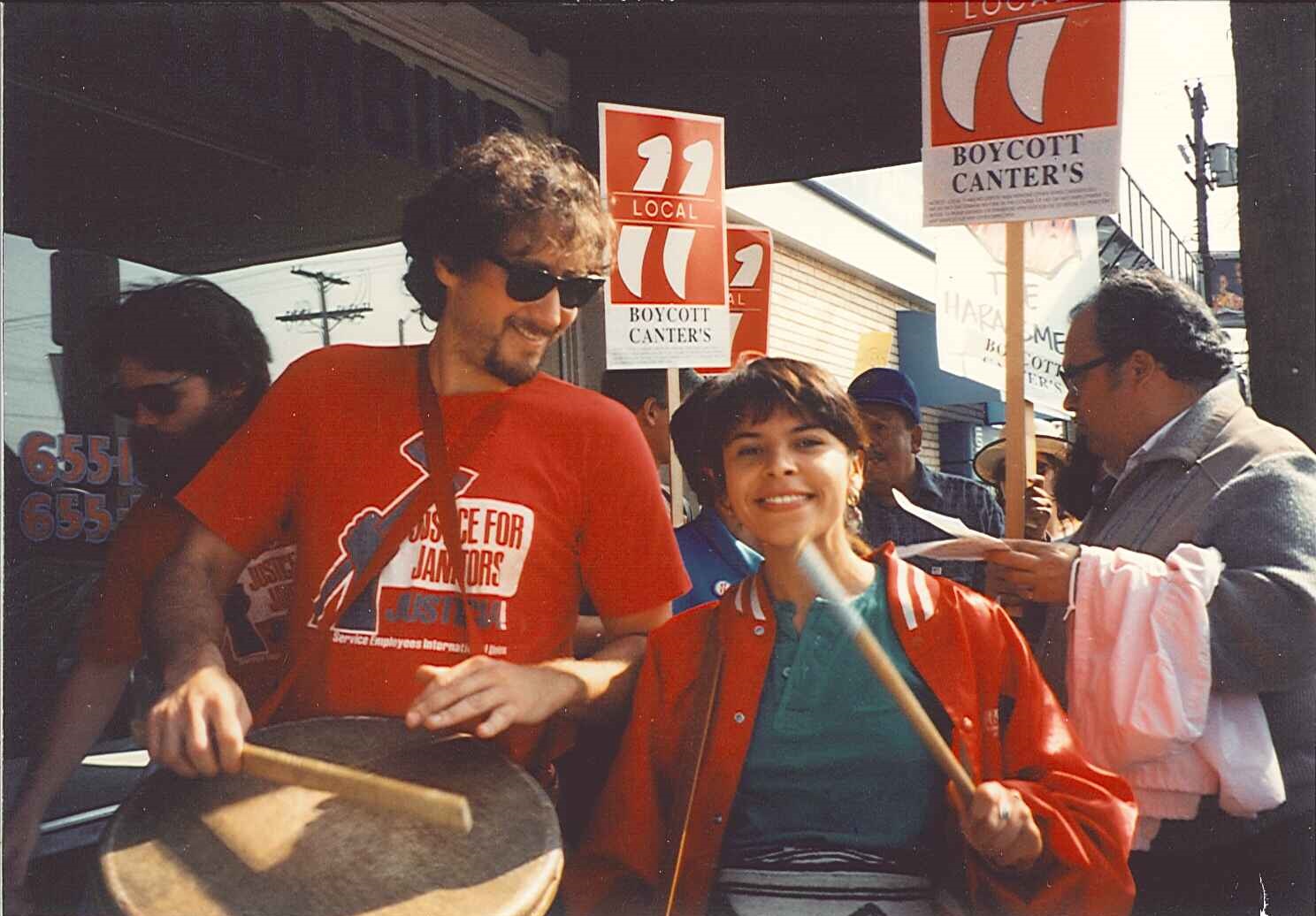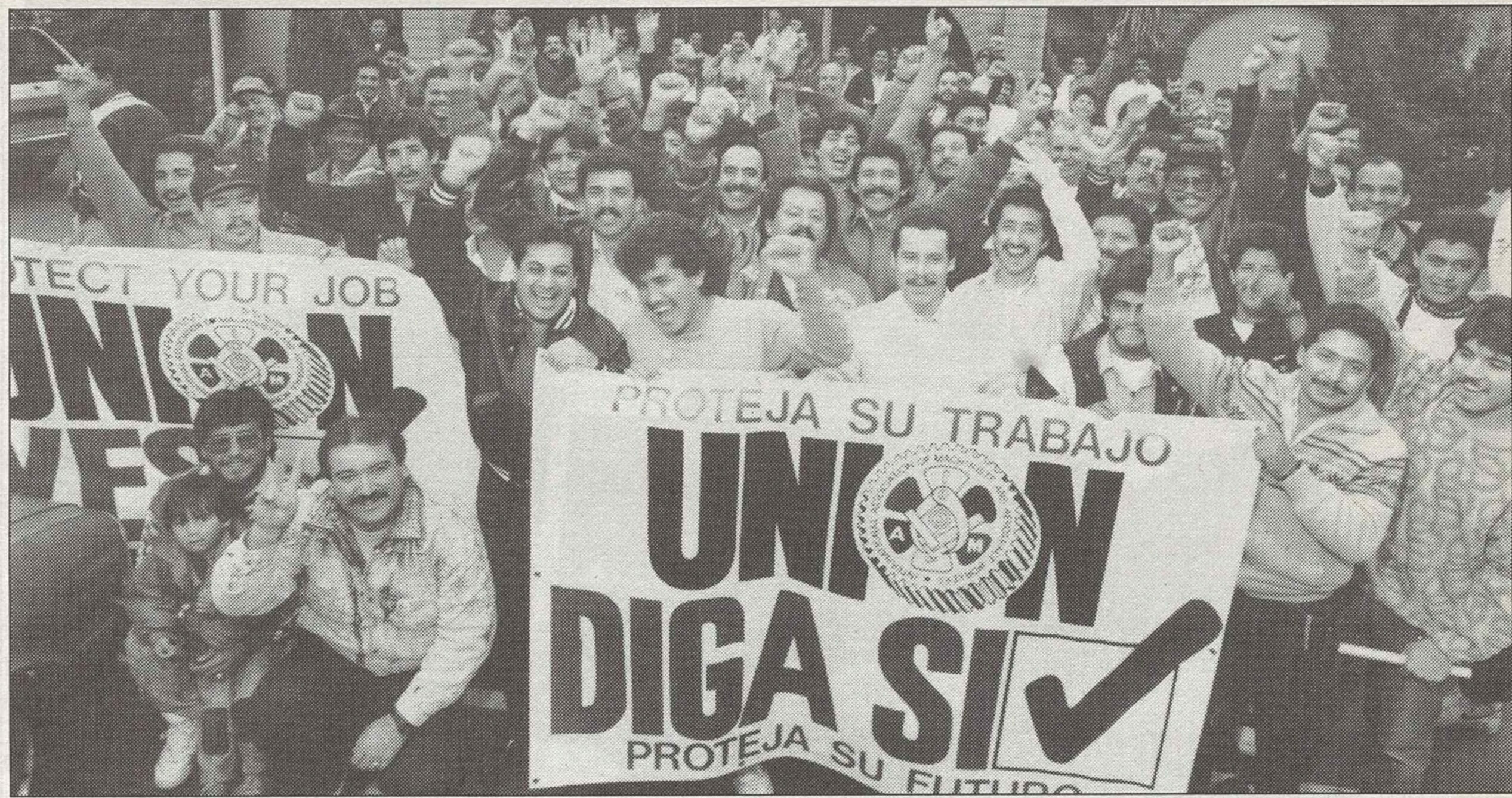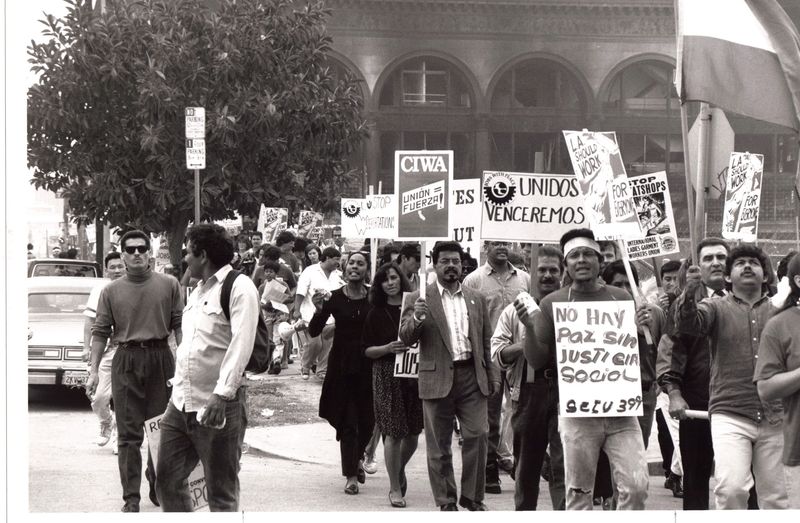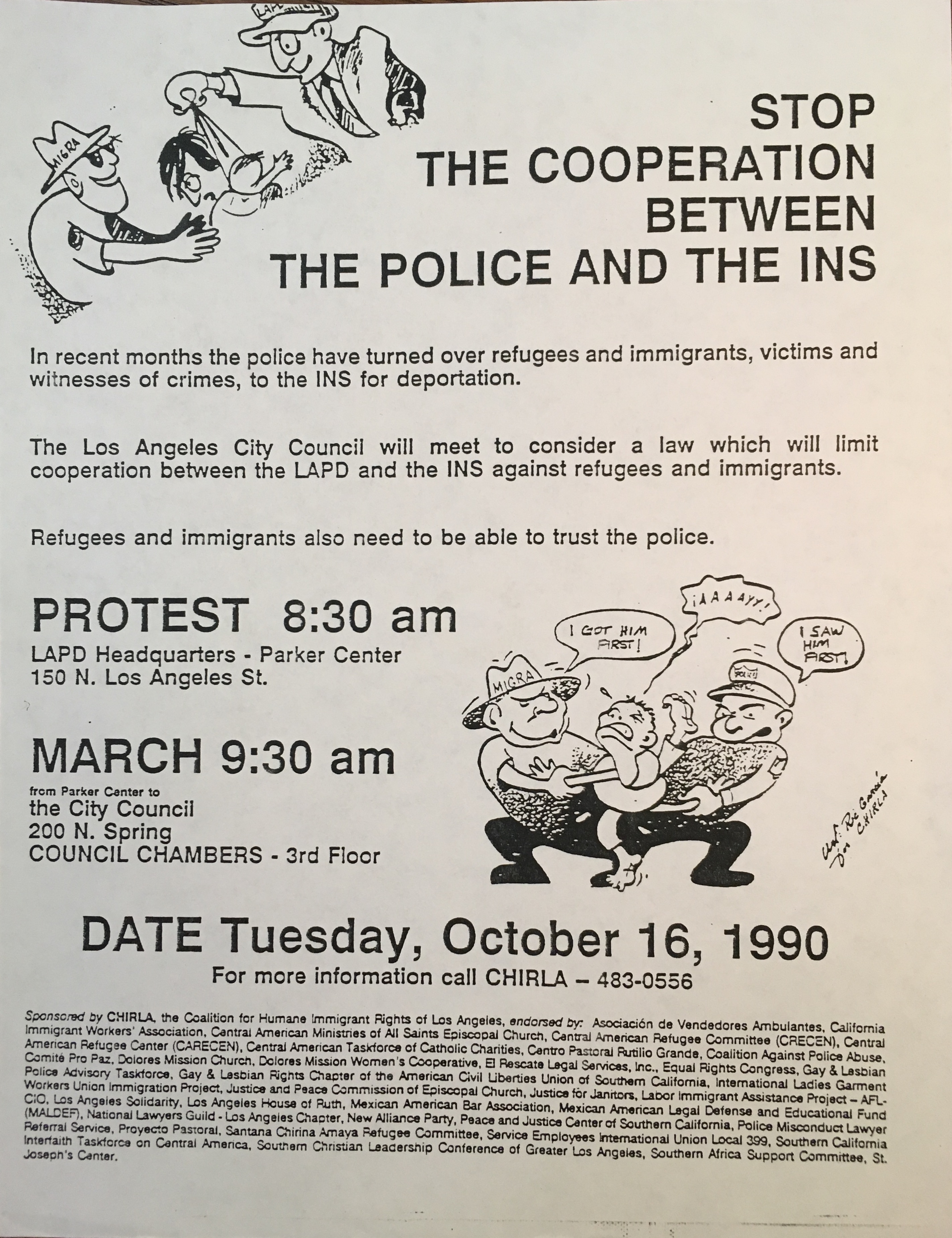In September 2006, UNITE HERE Local 11 organized what was likely the largest act of civil disobedience in Los Angeles History. Union members, faith leaders, elected officials, and community allies joined in a large march to protest low wages at corporate hotels along Century Blvd outside of Los Angeles International Airport. The protest demonstrated the union’s ability to build a broad coalition in support of worker and immigrant right at a time when the union was negotiating with hotel employers over a new contract. Building on the themes of the spring 2006 immigrant rights marches, Century Blvd. marchers also evoked the civil rights movement. The slogan “I am a Human Being” echoed the famous message Memphis sanitation workers strikers of 1968, “I am a Man.” Over 300 demonstrators were arrested by Los Angeles Police and bused to Van Nuys for processing. Produced by UNITE-HERE Local 11, this film combines TV news footage, interviews, and street scenes to document the union’s mass action on Century Blvd.
Tag: immigrant rights
-
I am a Human Being | Soy un Ser Humano
16175256 {41191:EKBD353R} 1 chicago-fullnote-bibliography 50 default 980 https://socialjusticehistory.irle.ucla.edu/wp-content/plugins/zotpress/%7B%22status%22%3A%22success%22%2C%22updateneeded%22%3Afalse%2C%22instance%22%3Afalse%2C%22meta%22%3A%7B%22request_last%22%3A0%2C%22request_next%22%3A0%2C%22used_cache%22%3Atrue%7D%2C%22data%22%3A%5B%7B%22key%22%3A%22EKBD353R%22%2C%22library%22%3A%7B%22id%22%3A41191%7D%2C%22meta%22%3A%7B%22creatorSummary%22%3A%22Mathews%22%2C%22parsedDate%22%3A%222006-09-28%22%2C%22numChildren%22%3A1%7D%2C%22bib%22%3A%22%26lt%3Bdiv%20class%3D%26quot%3Bcsl-bib-body%26quot%3B%20style%3D%26quot%3Bline-height%3A%201.35%3B%20padding-left%3A%201em%3B%20text-indent%3A-1em%3B%26quot%3B%26gt%3B%5Cn%20%20%26lt%3Bdiv%20class%3D%26quot%3Bcsl-entry%26quot%3B%26gt%3BMathews%2C%20Joe.%20%26%23x201C%3BThe%20State%3B%20A%20Plan%20for%20Very%20Civil%20Disobedience%3B%20Police%20and%20Union%20Will%20Follow%20a%20Script%2C%20Which%20Even%20Specifies%20Who%20Will%20Be%20Arrested%2C%20in%20a%20March%20near%20LAX%20to%20Organize%20Hotel%20Workers.%3A%26%23xA0%3B%5BHOME%20EDITION%5D.%26%23x201D%3B%20%26lt%3Bi%26gt%3BLos%20Angeles%20Times%3B%20Los%20Angeles%2C%20Calif.%26lt%3B%5C%2Fi%26gt%3B%2C%20September%2028%2C%202006%2C%20sec.%20Main%20News%3B%20Part%20A%3B%20Metro%20Desk.%20%26lt%3Ba%20class%3D%26%23039%3Bzp-ItemURL%26%23039%3B%20href%3D%26%23039%3Bhttp%3A%5C%2F%5C%2Fsearch.proquest.com%5C%2Flatimes%5C%2Fdocview%5C%2F422186033%5C%2Fabstract%5C%2F3B85F37323DB4A3CPQ%5C%2F13%26%23039%3B%26gt%3Bhttp%3A%5C%2F%5C%2Fsearch.proquest.com%5C%2Flatimes%5C%2Fdocview%5C%2F422186033%5C%2Fabstract%5C%2F3B85F37323DB4A3CPQ%5C%2F13%26lt%3B%5C%2Fa%26gt%3B.%26lt%3B%5C%2Fdiv%26gt%3B%5Cn%26lt%3B%5C%2Fdiv%26gt%3B%22%2C%22data%22%3A%7B%22itemType%22%3A%22newspaperArticle%22%2C%22title%22%3A%22The%20State%3B%20A%20Plan%20for%20Very%20Civil%20Disobedience%3B%20Police%20and%20union%20will%20follow%20a%20script%2C%20which%20even%20specifies%20who%20will%20be%20arrested%2C%20in%20a%20march%20near%20LAX%20to%20organize%20hotel%20workers.%3A%5Cu00a0%5BHOME%20EDITION%5D%22%2C%22creators%22%3A%5B%7B%22creatorType%22%3A%22author%22%2C%22firstName%22%3A%22Joe%22%2C%22lastName%22%3A%22Mathews%22%7D%5D%2C%22abstractNote%22%3A%22MAP%3A%20Protest%20planned%3B%20CREDIT%3A%20Los%20Angeles%20Times%3B%20PLANNING%3A%20%5BGlen%20Arnodo%5D%2C%20a%20top%20staffer%20for%20Unite%20Here%20Local%2011%2C%20addresses%20potential%20arrestees%20at%20the%20union%26%23039%3Bs%20headquarters.%20Arnodo%20gave%20a%20specific%20list%20of%20do%26%23039%3Bs%20and%20don%26%23039%3Bts%20to%20the%20audience.%3B%20PHOTOGRAPHER%3A%20Gary%20Friedman%20Los%20Angeles%20Times%3B%20ROLE-PLAYING%3A%20Sarah%20Nolan%2C%20left%2C%20and%20Sanjay%20Anand%20participate%20in%20nonviolence%20training%20at%20Unite%20Here%20Local%2011%26%23039%3Bs%20headquarters.%20The%20two%20will%20march%20in%20today%26%23039%3Bs%20protest%20near%20LAX.%3B%20PHOTOGRAPHER%3A%20Gary%20Friedman%20Los%20Angeles%20Times%22%2C%22date%22%3A%22Sep%2028%2C%202006%22%2C%22section%22%3A%22Main%20News%3B%20Part%20A%3B%20Metro%20Desk%22%2C%22language%22%3A%22English%22%2C%22ISSN%22%3A%2204583035%22%2C%22url%22%3A%22http%3A%5C%2F%5C%2Fsearch.proquest.com%5C%2Flatimes%5C%2Fdocview%5C%2F422186033%5C%2Fabstract%5C%2F3B85F37323DB4A3CPQ%5C%2F13%22%2C%22collections%22%3A%5B%22JEVPK733%22%5D%2C%22dateModified%22%3A%222017-01-27T06%3A25%3A45Z%22%7D%7D%5D%7DMathews, Joe. “The State; A Plan for Very Civil Disobedience; Police and Union Will Follow a Script, Which Even Specifies Who Will Be Arrested, in a March near LAX to Organize Hotel Workers.: [HOME EDITION].” Los Angeles Times; Los Angeles, Calif., September 28, 2006, sec. Main News; Part A; Metro Desk. http://search.proquest.com/latimes/docview/422186033/abstract/3B85F37323DB4A3CPQ/13. -
Los Angeles Immigrant Rights March, 2006
On May 1, 2006 hundreds of thousands marched in Los Angeles and other large U.S. cities in support of immigrant rights. Called by many “A Day without an Immigrant,” the May Day protests were the culmination of months of planning in response to a punitive immigration bill that passed the U.S. House of Representatives (H.R. 4437). This video is from the Los Angeles Independent Media Center (IMC, http://la.indymedia.org/news/2006/05/156112.php). Independent media in LA and elsewhere was an important venue for social movement news in the early 2000s, but in Los Angeles the large crowds were also mobilized by Spanish-language commercial radio and television stations that embraced the call to oppose H.R. 4437.
16175256 {41191:7NDUSUCZ} 1 chicago-fullnote-bibliography 50 default 998 https://socialjusticehistory.irle.ucla.edu/wp-content/plugins/zotpress/%7B%22status%22%3A%22success%22%2C%22updateneeded%22%3Afalse%2C%22instance%22%3Afalse%2C%22meta%22%3A%7B%22request_last%22%3A0%2C%22request_next%22%3A0%2C%22used_cache%22%3Atrue%7D%2C%22data%22%3A%5B%7B%22key%22%3A%227NDUSUCZ%22%2C%22library%22%3A%7B%22id%22%3A41191%7D%2C%22meta%22%3A%7B%22numChildren%22%3A1%7D%2C%22bib%22%3A%22%26lt%3Bdiv%20class%3D%26quot%3Bcsl-bib-body%26quot%3B%20style%3D%26quot%3Bline-height%3A%201.35%3B%20padding-left%3A%201em%3B%20text-indent%3A-1em%3B%26quot%3B%26gt%3B%5Cn%20%20%26lt%3Bdiv%20class%3D%26quot%3Bcsl-entry%26quot%3B%26gt%3B%26%23x201C%3BTHE%20MAY%20DAY%20MARCHES%3B%20Cities%26%23×2019%3B%20Immigrants%20Spoke%20One%20Language%20This%20Time%3B%20Rallies%20Attract%20More%20than%20a%20Million%20People%20of%20Varied%20Nationalities%20across%20the%20U.S.%20The%20Effect%20of%20the%20Economic%20Boycott%20Remains%20Unclear.%3A%20%5BHOME%20EDITION%5D%20-%20Los%20Angeles%20Times%20-%20ProQuest.%26%23x201D%3B%20Accessed%20January%2031%2C%202020.%20%26lt%3Ba%20class%3D%26%23039%3Bzp-ItemURL%26%23039%3B%20href%3D%26%23039%3Bhttps%3A%5C%2F%5C%2Fsearch.proquest.com%5C%2Flatimes%5C%2Fdocview%5C%2F422125282%5C%2FB0609268A41C4AB7PQ%5C%2F12%3Faccountid%3D14512%26%23039%3B%26gt%3Bhttps%3A%5C%2F%5C%2Fsearch.proquest.com%5C%2Flatimes%5C%2Fdocview%5C%2F422125282%5C%2FB0609268A41C4AB7PQ%5C%2F12%3Faccountid%3D14512%26lt%3B%5C%2Fa%26gt%3B.%26lt%3B%5C%2Fdiv%26gt%3B%5Cn%26lt%3B%5C%2Fdiv%26gt%3B%22%2C%22data%22%3A%7B%22itemType%22%3A%22webpage%22%2C%22title%22%3A%22THE%20MAY%20DAY%20MARCHES%3B%20Cities%27%20Immigrants%20Spoke%20One%20Language%20This%20Time%3B%20Rallies%20attract%20more%20than%20a%20million%20people%20of%20varied%20nationalities%20across%20the%20U.S.%20The%20effect%20of%20the%20economic%20boycott%20remains%20unclear.%3A%20%5BHOME%20EDITION%5D%20-%20Los%20Angeles%20Times%20-%20ProQuest%22%2C%22creators%22%3A%5B%5D%2C%22abstractNote%22%3A%22%22%2C%22date%22%3A%22%22%2C%22url%22%3A%22https%3A%5C%2F%5C%2Fsearch.proquest.com%5C%2Flatimes%5C%2Fdocview%5C%2F422125282%5C%2FB0609268A41C4AB7PQ%5C%2F12%3Faccountid%3D14512%22%2C%22language%22%3A%22en%22%2C%22collections%22%3A%5B%228ZEED72I%22%5D%2C%22dateModified%22%3A%222020-01-31T04%3A11%3A22Z%22%7D%7D%5D%7D“THE MAY DAY MARCHES; Cities’ Immigrants Spoke One Language This Time; Rallies Attract More than a Million People of Varied Nationalities across the U.S. The Effect of the Economic Boycott Remains Unclear.: [HOME EDITION] – Los Angeles Times – ProQuest.” Accessed January 31, 2020. https://search.proquest.com/latimes/docview/422125282/B0609268A41C4AB7PQ/12?accountid=14512.16175256 {41191:ZLPUZZC8} 1 chicago-fullnote-bibliography 50 default 998 https://socialjusticehistory.irle.ucla.edu/wp-content/plugins/zotpress/%7B%22status%22%3A%22success%22%2C%22updateneeded%22%3Afalse%2C%22instance%22%3Afalse%2C%22meta%22%3A%7B%22request_last%22%3A0%2C%22request_next%22%3A0%2C%22used_cache%22%3Atrue%7D%2C%22data%22%3A%5B%7B%22key%22%3A%22ZLPUZZC8%22%2C%22library%22%3A%7B%22id%22%3A41191%7D%2C%22meta%22%3A%7B%22creatorSummary%22%3A%22Watanabe%20and%20Gaouette%22%2C%22parsedDate%22%3A%222006-05-02%22%2C%22numChildren%22%3A1%7D%2C%22bib%22%3A%22%26lt%3Bdiv%20class%3D%26quot%3Bcsl-bib-body%26quot%3B%20style%3D%26quot%3Bline-height%3A%201.35%3B%20padding-left%3A%201em%3B%20text-indent%3A-1em%3B%26quot%3B%26gt%3B%5Cn%20%20%26lt%3Bdiv%20class%3D%26quot%3Bcsl-entry%26quot%3B%26gt%3BWatanabe%2C%20Teresa%2C%20and%20Nicole%20Gaouette.%20%26%23x201C%3BThe%20May%20Day%20Marches.%20News%20Analysis.%20Next%3A%20Converting%20the%20Energy%20of%20Protest%20to%20Political%20Clout.%26%23x201D%3B%20%26lt%3Bi%26gt%3BLos%20Angeles%20Times%26lt%3B%5C%2Fi%26gt%3B%2C%20May%202%2C%202006%2C%20sec.%20Main%20News%3B%20Part%20A%3B%20Metro%20Desk.%20%26lt%3Ba%20class%3D%26%23039%3Bzp-ItemURL%26%23039%3B%20href%3D%26%23039%3Bhttps%3A%5C%2F%5C%2Fsearch.proquest.com%5C%2Flatimes%5C%2Fdocview%5C%2F422113508%5C%2Fabstract%5C%2FD0B0D36B257A4D95PQ%5C%2F1%26%23039%3B%26gt%3Bhttps%3A%5C%2F%5C%2Fsearch.proquest.com%5C%2Flatimes%5C%2Fdocview%5C%2F422113508%5C%2Fabstract%5C%2FD0B0D36B257A4D95PQ%5C%2F1%26lt%3B%5C%2Fa%26gt%3B.%26lt%3B%5C%2Fdiv%26gt%3B%5Cn%26lt%3B%5C%2Fdiv%26gt%3B%22%2C%22data%22%3A%7B%22itemType%22%3A%22newspaperArticle%22%2C%22title%22%3A%22The%20May%20Day%20Marches.%20News%20Analysis.%20Next%3A%20Converting%20the%20Energy%20of%20Protest%20to%20Political%20Clout%22%2C%22creators%22%3A%5B%7B%22creatorType%22%3A%22author%22%2C%22firstName%22%3A%22Teresa%22%2C%22lastName%22%3A%22Watanabe%22%7D%2C%7B%22creatorType%22%3A%22author%22%2C%22firstName%22%3A%22Nicole%22%2C%22lastName%22%3A%22Gaouette%22%7D%5D%2C%22abstractNote%22%3A%22In%20contrast%2C%20the%20Senate%20Judiciary%20Committee%20in%20March%20passed%20a%20bill%20viewed%20as%20more%20favorable%20to%20immigrants.%20It%20includes%20an%20expanded%20guest%20worker%20program%20and%20a%20chance%20for%20undocumented%20migrants%20currently%20in%20the%20U.S.%20to%20gain%20legal%20status%20by%20paying%20a%20fine%20and%20learning%20English%2C%20among%20other%20steps.%5CnInfluential%20figures%2C%20including%20Spanish-language%20radio%20DJ%20Eddie%20%26quot%3BEl%20Piolin%26quot%3B%20Sotelo%2C%20urged%20downtown%20demonstrators%20to%20become%20U.S.%20citizens%2C%20a%20suggestion%20greeted%20with%20roars%20of%20approval.%5CnBANNER%20DAY%3A%20Lola%20Maldonado%2C%20with%20the%20colors%20of%20the%20American%20flag%20painted%20on%20her%20face%2C%20awaits%20the%20start%20of%20the%20Wilshire%20Boulevard%20march%20from%20MacArthur%20Park%20in%20Los%20Angeles.%20The%20second%20of%20two%20major%20marches%20on%20Monday%2C%20it%20was%20peaceful%2C%20seeming%20more%20like%20a%20fiesta%20than%20a%20protest.%3B%20PHOTOGRAPHER%3A%20Robert%20Gauthier%20Los%20Angeles%20Times%3B%20A%20MASS%20TRANSIT%3A%20Hundreds%20of%20thousands%20march%20along%20Wilshire%20Boulevard.%20Activists%20say%20they%26%23039%3Bll%20begin%20shifting%20from%20demonstration%20to%20registration%2C%20hoping%20to%20turn%20the%20protest%20energy%20into%20political%20power.%3B%20PHOTOGRAPHER%3A%20Bryan%20Chan%20Los%20Angeles%20Times%22%2C%22date%22%3A%22May%202%2C%202006%22%2C%22section%22%3A%22Main%20News%3B%20Part%20A%3B%20Metro%20Desk%22%2C%22language%22%3A%22English%22%2C%22ISSN%22%3A%2204583035%22%2C%22url%22%3A%22https%3A%5C%2F%5C%2Fsearch.proquest.com%5C%2Flatimes%5C%2Fdocview%5C%2F422113508%5C%2Fabstract%5C%2FD0B0D36B257A4D95PQ%5C%2F1%22%2C%22collections%22%3A%5B%22S55LDACD%22%5D%2C%22dateModified%22%3A%222021-03-01T05%3A25%3A28Z%22%7D%7D%5D%7DWatanabe, Teresa, and Nicole Gaouette. “The May Day Marches. News Analysis. Next: Converting the Energy of Protest to Political Clout.” Los Angeles Times, May 2, 2006, sec. Main News; Part A; Metro Desk. https://search.proquest.com/latimes/docview/422113508/abstract/D0B0D36B257A4D95PQ/1. -

We call each other sister unions
Rocio Sáenz recalls the spirit of solidarity among unions in the early 1990s
I come from Mexico City, and I had a union there. Even though, looking back at the unions in Mexico, they were often very corrupt, at the time I thought it was better than nothing. When I came to the U.S., I did a lot of different jobs. I was a domestic worker, I was a salesperson in a store, and stuff like that. But I wanted to be in a unionized workplace, and so I was trying to get a job through a local union. I didn’t know that there was such a thing as being an organizer, but I was making posters and banners for he ILGWU. A few months later, I met someone in Local 11 of HERE and they hired me. Even then, for a few months, I didn’t do organizing. I didn’t even know what it was. But then I got very involved.
I saw a different way to organize [in HERE]. To bring the trust back from the members, and to show that this was a different union. In any organizing drive, you have to show the workers that, yes, you can make a difference. Little victories that you have to deliver, in order to say there is a change. It has to be very, very specific and concrete. And you have to see things as industry-wide. When I was with HERE I remember organizing my first hotel, reorganizing it for the first time in then years. That was in Manhattan Beach, close to the airport. We did it through elections. Well we organized 300 workers, and that was not going to make a big difference for the industry. You have to look at the whole industry, instead of one single work site. You have to do it in a market competitive way. If you’re going to organize, it has to be like all of downtown L.A. has got to go union. It has to be a long-term plan It takes a lot of effort, a lot of persistence, and a lot of resources.
(more…) -

We were the union they’d call
Cristina Vázquez on the lessons of organizing immigrant workers in the 1970s
In 1976, when I started working for the ILGWU, we had several thousand members, but for ten years they had hardly organized a shop. The union had not paid much attention to the situation in L.A. … but then the ILGWU decided to bring an organizing director from back east, Phil Russo. He was an organizer himself and he had a vision. He thought there was a lot of potential here, and he said he was going to find and hire the best organizers. He started going to the universities and recruiting people who were active in political groups. He put a team together, and among them was my husband, Mario F. Vázquez, who had just graduated from UCLA law school after emigrating from Mexico at age 15. He saw this ad, “Organizers Needed at ILGWU.” At the time he was doing some volunteer work for CASA (Centro de Acción Social Autónomo), the Chicano pro-immigrant organization, writing and translating for its newspaper, Sin Fronteras [Without Borders], and doing all this political work.
(more…) -

“Immigrant workers have always agreed with us philosophically”
In this excerpt of a 1995 speech on multi-union organizing strategy, David Sickler recounts the changing relationship between immigrant workers and organized labor in southern California and identifies some of the mistakes unions have made in their approach to immigrant workers. As the Regional Director for the AFL-CIO and head of the Los Angeles-Orange County Organizing Committee (LAOCOC), Sickler launched the California Immigrant Workers Association (CIWA) to organize undocumented workers into unions. This speech was delivered at the UCLA Labor Center.
Now I’m somebody who’s tried to organize immigrant workers in this town for 20 years. We’ve had some success here and there, but the movement’s never been able to prove to immigrant workers that it could deliver. That it could put its money where its mouth was.
Immigrant workers have always agreed with us philosophically. They know we’re advocates; they know we’re on their side. But they’ve been reluctant to get on board with us on a large scale because they’ve watched our failures. They know that some of our own unions in the past, when they’d go out and organize companies that had immigrant workers, if those workers went on strike and the employer replaced them with other immigrant workers, the union would call the INS and have the scab workers deported. The employer would then call the INS and have the strikers deported. That’s a great deal for immigrant workers. Welcome! Welcome to the institutions of the United States. But the labor movement changed its act in the 70s and the 80s, and we aren’t doing those kinds of things any more. Still, these workers just weren’t sure we could deliver. What happened with the signing of the Justice for Janitors contract sent shockwaves through the immigrant community in Southern California. It will never be the same, ever. Because about six months after the signing of that contract, 900 workers at American Racing Equipment in Rancho Domingas-and I’m telling you it’s 100 percent immigrant-staged a five-day walkout.
(more…) -
On Any Day (1995)
The Tourism Industry Development Board (later known as the Los Angeles Alliance for a New Economy, or LAANE) takes visiting journalists on a tour of four Los Angeles working class neighborhoods. LAANE’s partnership with HERE Local 11 aimed to change the public perception of Los Angeles and highlight the lives of tourism industry workers.
16175256 {41191:KEA8ZXAH} 1 chicago-fullnote-bibliography 50 default 976 https://socialjusticehistory.irle.ucla.edu/wp-content/plugins/zotpress/%7B%22status%22%3A%22success%22%2C%22updateneeded%22%3Afalse%2C%22instance%22%3Afalse%2C%22meta%22%3A%7B%22request_last%22%3A0%2C%22request_next%22%3A0%2C%22used_cache%22%3Atrue%7D%2C%22data%22%3A%5B%7B%22key%22%3A%22KEA8ZXAH%22%2C%22library%22%3A%7B%22id%22%3A41191%7D%2C%22meta%22%3A%7B%22creatorSummary%22%3A%22McDONNELL%22%2C%22parsedDate%22%3A%221994-07-07%22%2C%22numChildren%22%3A1%7D%2C%22bib%22%3A%22%26lt%3Bdiv%20class%3D%26quot%3Bcsl-bib-body%26quot%3B%20style%3D%26quot%3Bline-height%3A%201.35%3B%20padding-left%3A%201em%3B%20text-indent%3A-1em%3B%26quot%3B%26gt%3B%5Cn%20%20%26lt%3Bdiv%20class%3D%26quot%3Bcsl-entry%26quot%3B%26gt%3BMcDONNELL%2C%20PATRICK%20J.%20%26%23x201C%3BCultural%20Mystery%20Tour%20Visitors%3A%20Bus%20Trip%20to%20L.A.%26%23×2019%3Bs%20Eastside%20Kicks%20off%20a%20Series%20That%20Will%20Showcase%20the%20City%26%23×2019%3Bs%20Often-Overlooked%20Multiethnic%20Attractions%20and%20Counter%20Negative%20Media%20Images.%20Koreatown%2C%20South-Central%20Are%20among%20Future%20Destinations.%3A%26%23xA0%3B%5BHome%20Edition%5D.%26%23x201D%3B%20%26lt%3Bi%26gt%3BLos%20Angeles%20Times%20%28Pre-1997%20Fulltext%29%3B%20Los%20Angeles%2C%20Calif.%26lt%3B%5C%2Fi%26gt%3B%2C%20July%207%2C%201994%2C%20sec.%20Metro%3B%20PART-B%3B%20Metro%20Desk.%20%26lt%3Ba%20class%3D%26%23039%3Bzp-ItemURL%26%23039%3B%20href%3D%26%23039%3Bhttp%3A%5C%2F%5C%2Fsearch.proquest.com%5C%2Flatimes%5C%2Fdocview%5C%2F282359935%5C%2Fabstract%5C%2FD7B4B159EE014446PQ%5C%2F1%26%23039%3B%26gt%3Bhttp%3A%5C%2F%5C%2Fsearch.proquest.com%5C%2Flatimes%5C%2Fdocview%5C%2F282359935%5C%2Fabstract%5C%2FD7B4B159EE014446PQ%5C%2F1%26lt%3B%5C%2Fa%26gt%3B.%26lt%3B%5C%2Fdiv%26gt%3B%5Cn%26lt%3B%5C%2Fdiv%26gt%3B%22%2C%22data%22%3A%7B%22itemType%22%3A%22newspaperArticle%22%2C%22title%22%3A%22Cultural%20Mystery%20Tour%20Visitors%3A%20Bus%20trip%20to%20L.A.%27s%20Eastside%20kicks%20off%20a%20series%20that%20will%20showcase%20the%20city%27s%20often-overlooked%20multiethnic%20attractions%20and%20counter%20negative%20media%20images.%20Koreatown%2C%20South-Central%20are%20among%20future%20destinations.%3A%5Cu00a0%5BHome%20Edition%5D%22%2C%22creators%22%3A%5B%7B%22creatorType%22%3A%22author%22%2C%22firstName%22%3A%22PATRICK%20J.%22%2C%22lastName%22%3A%22McDONNELL%22%7D%5D%2C%22abstractNote%22%3A%22As%20the%20tour%20bus-on%20loan%20from%20the%20Metropolitan%20Transportation%20Authority-cruised%20down%20Whittier%20Boulevard%20in%20East%20Los%20Angeles%2C%20Jesus%20Salvador%20Trevino%2C%20a%20filmmaker%20who%20was%20reared%20on%20the%20Eastside%2C%20spoke%20over%20the%20intercom%20about%20the%20infamous%20events%20of%20Aug.%2029%2C%201970%2C%20when%20protesters%20and%20police%20clashed%20in%20what%20is%20remembered%20as%20the%20largest%20Chicano%20demonstration%20ever.%5CnFor%20Daniel%20Bernheim%2C%20who%20writes%20from%20Los%20Angeles%20for%20the%20Glasgow%2C%20Scotland-based%20Herald%2C%20the%20visit%20provided%20a%20pleasant%20contrast%20to%20his%20media-shaped%20preconceptions%20of%20the%20Eastside.%20%26quot%3BI%20had%20a%20certain%20image%20from%20these%20sensationalistic%20headlines%2C%26quot%3B%20Bernheim%20said.%5CnPHOTO%3A%20COLOR%2C%20Journalists%20on%20a%20tour%20of%20the%20city%26%23039%3Bs%20Eastside%20visit%20Self-Help%20Graphics%2C%20where%20they%20watch%20Jose%20Alpuche%20do%20silk-screening.%20%5C%2F%20VINCE%20COMPAGNONE%20%5C%2F%20Los%20Angeles%20Times%3B%20PHOTO%3A%20COLOR%2C%20The%20World%20Cup%20journalists%20look%20at%20the%20work%20of%20Martin%20Garcia%20and%20others%20in%20the%20etching%20studio%20at%20Self-Help%20Graphics.%3B%20PHOTO%3A%20%28A2%29%20Soccer%20Break%3A%20Visiting%20journalists%20covering%20the%20World%20Cup%20took%20a%20bus%20tour%20of%20eastern%20Los%20Angeles%20as%20part%20of%20a%20community-based%20effort%20to%20give%20them%20a%20touch%20of%20Los%20Angeles%20distinct%20from%20the%20glitzy%20image%20prevalent%20on%20brochures.%20Above%2C%20the%20group%20disembarks%20at%20Dolores%20Mission%20Church.%20%5C%2F%20VINCE%20COMPAGNONE%20%5C%2F%20Los%20Angeles%20Times%22%2C%22date%22%3A%22Jul%207%2C%201994%22%2C%22section%22%3A%22Metro%3B%20PART-B%3B%20Metro%20Desk%22%2C%22language%22%3A%22English%22%2C%22ISSN%22%3A%2204583035%22%2C%22url%22%3A%22http%3A%5C%2F%5C%2Fsearch.proquest.com%5C%2Flatimes%5C%2Fdocview%5C%2F282359935%5C%2Fabstract%5C%2FD7B4B159EE014446PQ%5C%2F1%22%2C%22collections%22%3A%5B%225DU3R7CV%22%5D%2C%22dateModified%22%3A%222017-01-28T06%3A10%3A26Z%22%7D%7D%5D%7DMcDONNELL, PATRICK J. “Cultural Mystery Tour Visitors: Bus Trip to L.A.’s Eastside Kicks off a Series That Will Showcase the City’s Often-Overlooked Multiethnic Attractions and Counter Negative Media Images. Koreatown, South-Central Are among Future Destinations.: [Home Edition].” Los Angeles Times (Pre-1997 Fulltext); Los Angeles, Calif., July 7, 1994, sec. Metro; PART-B; Metro Desk. http://search.proquest.com/latimes/docview/282359935/abstract/D7B4B159EE014446PQ/1. -

On a mission to organize immigrant workers
Launched in 1989, the California Immigrant Workers Association (CIWA) supported a number of break-through union campaigns with immigrant workers. David Sickler, regional director for the AFL-CIO, conceived of CIWA as a way to funnel support for the many organizing drives that developed in the wake of the Immigration Reform and Control Act. CIWA staff provided legal and organizing aid to immigrant workers and connected them with unions, and advised unions on organizing best practices. However, in the spring of 1994 national leaders of the AFL-CIO decided to stop funding the program. In a memo to local union leaders, Sickler and CIWA staffer Jose De Paz appeal to southern California union leaders to help fund CIWA. The demise of CIWA came just months before immigrant rights groups and unions scrambled to fight the anti-immigrant Proposition 187 in the November 1994 election.
From the UNITE HERE Local 11 Records, Box 17 Folder 6, UCLA Library Department of Special Collections.
16175256 {41191:HAM8QFLB} 1 chicago-fullnote-bibliography 50 default 2534 https://socialjusticehistory.irle.ucla.edu/wp-content/plugins/zotpress/%7B%22status%22%3A%22success%22%2C%22updateneeded%22%3Afalse%2C%22instance%22%3Afalse%2C%22meta%22%3A%7B%22request_last%22%3A0%2C%22request_next%22%3A0%2C%22used_cache%22%3Atrue%7D%2C%22data%22%3A%5B%7B%22key%22%3A%22HAM8QFLB%22%2C%22library%22%3A%7B%22id%22%3A41191%7D%2C%22meta%22%3A%7B%22creatorSummary%22%3A%22Baker%22%2C%22parsedDate%22%3A%221991-03-25%22%2C%22numChildren%22%3A1%7D%2C%22bib%22%3A%22%26lt%3Bdiv%20class%3D%26quot%3Bcsl-bib-body%26quot%3B%20style%3D%26quot%3Bline-height%3A%201.35%3B%20padding-left%3A%201em%3B%20text-indent%3A-1em%3B%26quot%3B%26gt%3B%5Cn%20%20%26lt%3Bdiv%20class%3D%26quot%3Bcsl-entry%26quot%3B%26gt%3BBaker%2C%20Bob.%20%26%23x201C%3BUnions%20Try%20Bilingual%20Recruiting%3A%26%23xA0%3BA%20Handful%20of%20Aggressive%20Local%20Organizers%20Are%20Making%20Unprecedented%20Efforts%20to%20Replenish%20Their%20Ranks%20with%20Immigrant%20Workers%2C%20Especially%20Latinos.%20So%20Far%2C%20the%20Strategy%20Is%20Paying%20Off.%26%23x201D%3B%20%26lt%3Bi%26gt%3BLos%20Angeles%20Times%20%281923-1995%29%3B%20Los%20Angeles%2C%20Calif.%26lt%3B%5C%2Fi%26gt%3B%2C%20March%2025%2C%201991.%20%26lt%3Ba%20class%3D%26%23039%3Bzp-ItemURL%26%23039%3B%20href%3D%26%23039%3Bhttps%3A%5C%2F%5C%2Fsearch.proquest.com%5C%2Fhnplatimes%5C%2Fdocview%5C%2F1638431258%5C%2Fabstract%5C%2F23F841F81AA34934PQ%5C%2F360%26%23039%3B%26gt%3Bhttps%3A%5C%2F%5C%2Fsearch.proquest.com%5C%2Fhnplatimes%5C%2Fdocview%5C%2F1638431258%5C%2Fabstract%5C%2F23F841F81AA34934PQ%5C%2F360%26lt%3B%5C%2Fa%26gt%3B.%26lt%3B%5C%2Fdiv%26gt%3B%5Cn%26lt%3B%5C%2Fdiv%26gt%3B%22%2C%22data%22%3A%7B%22itemType%22%3A%22newspaperArticle%22%2C%22title%22%3A%22Unions%20Try%20Bilingual%20Recruiting%3A%5Cu00a0A%20handful%20of%20aggressive%20local%20organizers%20are%20making%20unprecedented%20efforts%20to%20replenish%20their%20ranks%20with%20immigrant%20workers%2C%20especially%20Latinos.%20So%20far%2C%20the%20strategy%20is%20paying%20off%22%2C%22creators%22%3A%5B%7B%22creatorType%22%3A%22author%22%2C%22firstName%22%3A%22Bob%22%2C%22lastName%22%3A%22Baker%22%7D%5D%2C%22abstractNote%22%3A%22Not%20many%20years%20ago%2C%20most%20American%20labor%20unions%20did%20not%20have%20much%20use%20for%20a%20newly%20arrived%20immigrant%20such%20as%20Roberto%20Rodriguez.%20Immigrants%20were%20often%20here%20illegally%2C%20did%20not%20speak%20English%20and%20were%20regarded%20as%20potential%20strikebreakers.%22%2C%22date%22%3A%22Mar%2025%2C%201991%22%2C%22section%22%3A%22%22%2C%22language%22%3A%22English%22%2C%22ISSN%22%3A%2204583035%22%2C%22url%22%3A%22https%3A%5C%2F%5C%2Fsearch.proquest.com%5C%2Fhnplatimes%5C%2Fdocview%5C%2F1638431258%5C%2Fabstract%5C%2F23F841F81AA34934PQ%5C%2F360%22%2C%22collections%22%3A%5B%22738WUB59%22%2C%22S55LDACD%22%5D%2C%22dateModified%22%3A%222021-02-11T04%3A55%3A12Z%22%7D%7D%5D%7DBaker, Bob. “Unions Try Bilingual Recruiting: A Handful of Aggressive Local Organizers Are Making Unprecedented Efforts to Replenish Their Ranks with Immigrant Workers, Especially Latinos. So Far, the Strategy Is Paying Off.” Los Angeles Times (1923-1995); Los Angeles, Calif., March 25, 1991. https://search.proquest.com/hnplatimes/docview/1638431258/abstract/23F841F81AA34934PQ/360. -
Pueblo, Unete! Vigil, March, and Mass for Immigrant Rights (1993)
In the fall of 1993, conservative political operatives began circulating plans for an anti-immigrant California ballot proposition, what would become Proposition 187. Advocates of immigrant- and worker-rights raised alarms immediately, and mounted a vigorous opposition campaign. Voters approved Prop. 187 in 1994, but it was struck down by a federal judge. The fight against the anti-immigrant law helped propel a new progressive political coalition in California. This short film documents a vigil, march, and mass held in October 1993 in the name of Father Luis Olivares, the first to declare sanctuary for Central American refugees. It features the actor Martin Sheen and Maria Elena Durazo, president of HERE Local 11.
16175256 {41191:ZQG2UJJ7} 1 chicago-fullnote-bibliography 50 default 1059 https://socialjusticehistory.irle.ucla.edu/wp-content/plugins/zotpress/%7B%22status%22%3A%22success%22%2C%22updateneeded%22%3Afalse%2C%22instance%22%3Afalse%2C%22meta%22%3A%7B%22request_last%22%3A0%2C%22request_next%22%3A0%2C%22used_cache%22%3Atrue%7D%2C%22data%22%3A%5B%7B%22key%22%3A%22ZQG2UJJ7%22%2C%22library%22%3A%7B%22id%22%3A41191%7D%2C%22meta%22%3A%7B%22creatorSummary%22%3A%22Garc%5Cu00eda%22%2C%22parsedDate%22%3A%222018%22%2C%22numChildren%22%3A0%7D%2C%22bib%22%3A%22%26lt%3Bdiv%20class%3D%26quot%3Bcsl-bib-body%26quot%3B%20style%3D%26quot%3Bline-height%3A%201.35%3B%20padding-left%3A%201em%3B%20text-indent%3A-1em%3B%26quot%3B%26gt%3B%5Cn%20%20%26lt%3Bdiv%20class%3D%26quot%3Bcsl-entry%26quot%3B%26gt%3BGarc%26%23xED%3Ba%2C%20Mario%20T.%20%26lt%3Bi%26gt%3BFather%20Luis%20Olivares%2C%20a%20Biography%3A%20Faith%20Politics%20and%20the%20Origins%20of%20the%20Sanctuary%20Movement%20in%20Los%20Angeles%26lt%3B%5C%2Fi%26gt%3B.%20Chapel%20Hill%3A%20The%20University%20of%20North%20Carolina%20Press%2C%202018.%20%26lt%3Ba%20class%3D%26%23039%3Bzp-ItemURL%26%23039%3B%20href%3D%26%23039%3Bhttps%3A%5C%2F%5C%2Fwww.jstor.org%5C%2Fstable%5C%2F10.5149%5C%2F9781469643335_garcia%26%23039%3B%26gt%3Bhttps%3A%5C%2F%5C%2Fwww.jstor.org%5C%2Fstable%5C%2F10.5149%5C%2F9781469643335_garcia%26lt%3B%5C%2Fa%26gt%3B.%26lt%3B%5C%2Fdiv%26gt%3B%5Cn%26lt%3B%5C%2Fdiv%26gt%3B%22%2C%22data%22%3A%7B%22itemType%22%3A%22book%22%2C%22title%22%3A%22Father%20Luis%20Olivares%2C%20a%20biography%3A%20faith%20politics%20and%20the%20origins%20of%20the%20sanctuary%20movement%20in%20Los%20Angeles%22%2C%22creators%22%3A%5B%7B%22creatorType%22%3A%22author%22%2C%22firstName%22%3A%22Mario%20T.%22%2C%22lastName%22%3A%22Garc%5Cu00eda%22%7D%5D%2C%22abstractNote%22%3A%22%26quot%3BThis%20is%20the%20amazing%20untold%20story%20of%20the%20Los%20Angeles%20sanctuary%20movement%26%23039%3Bs%20champion%2C%20Father%20Luis%20Olivares%20%281934-1993%29%2C%20a%20Catholic%20priest%20and%20a%20charismatic%2C%20faith-driven%20leader%20for%20social%20justice.%20Based%20on%20previously%20unexplored%20archives%20and%20over%20ninety%20oral%20histories%2C%20this%20compelling%20biography%20traces%20the%20life%20of%20a%20complex%20and%20constantly%20evolving%20individual%2C%20from%20Olivares%26%23039%3Bs%20humble%20beginnings%20in%20San%20Antonio%2C%20Texas%2C%20to%20his%20close%20friendship%20with%20legendary%20civil%20rights%20leader%20C%5Cu00e9sar%20Ch%5Cu00e1vez%20and%20his%20historic%20leadership%20of%20the%20United%20Neighborhoods%20Organization%20and%20the%20sanctuary%20movement%26quot%3B–%22%2C%22date%22%3A%222018%22%2C%22language%22%3A%22%22%2C%22ISBN%22%3A%22978-1-4696-4332-8%20978-1-4696-4333-5%22%2C%22url%22%3A%22https%3A%5C%2F%5C%2Fwww.jstor.org%5C%2Fstable%5C%2F10.5149%5C%2F9781469643335_garcia%22%2C%22collections%22%3A%5B%22IMGJPTTG%22%5D%2C%22dateModified%22%3A%222021-01-02T17%3A41%3A09Z%22%7D%7D%5D%7DGarcía, Mario T. Father Luis Olivares, a Biography: Faith Politics and the Origins of the Sanctuary Movement in Los Angeles. Chapel Hill: The University of North Carolina Press, 2018. https://www.jstor.org/stable/10.5149/9781469643335_garcia. -
“They embraced their cause 24 hours a day”
In the summer of 1992, immigrant construction workers across southern California launched a militant strike that surprised both their employers and the Anglo leaders of trade unions. Aided by the California Immigrant Workers Association (CIWA), the drywallers' strike succeeded in improving working conditions in residential construction across the region. This account is from CIWA organizer Jose De Paz. CIWA operated from 1989-1994 as an associate membership organization of the AFL-CIO.
Three main ingredients account for the success of the drywallers strike. First, the determination of the strikers. They were not doing “strike duty”. They embraced their cause 24 hours a day and everything else became secondary to the strike. Additionally, the strikers were aware that they were being oppressed not only as workers but also as Mexicans, which made their bond twice as strong. This came particularly handy when entire families were evicted from their homes for non-payment of rent and had to move in with one or more families in a single dwelling.
Second, organized labor’s considerable contribution to the independent drywall strike fund. In addition to individuals and community organizations, more than 21 AFL-CIO affiliated unions and six Central Labor Councils in California made significant donations to the fund.
Third, CIWA’s unique participation. Besides coordinating legal and immigration defense, CIWA served as a communication bridge between the strikers and police agencies. CIWA also functioned as the strikers’ spokesperson with the media (particularly the Spanish-language media) and as the coordinator of support from Latino community and labor organizations. CIWA’s unique com bination of skills and its dual credentials in the labor and Latino communities enabled it to convert the drywallers’ struggle from a localized labor dispute into a Latino workers movement.
(more…) -

Stop the Cooperation between the Police and the INS
A flyer announcing a protest rally and march organized by the Coalition for Humane Immigrant Rights of Los Angeles (CHIRLA) in the fall of 1990. Formed in the wake of the 1986 Immigration Reform and Control Act, CHIRLA drew together organizations and activists from many communities to demand inclusion for immigrants. Reflecting growing progressive coalition in Los Angeles, co-sponsors of this rally included labor unions, religious, civil liberties, and immigrant rights organizations Los Angeles. From the Tom Bradley Papers, Box 1170, folder 9, UCLA Special Collections. Download the Document.
16175256 {41191:HB8R8XTH} 1 chicago-fullnote-bibliography 50 default 2324 https://socialjusticehistory.irle.ucla.edu/wp-content/plugins/zotpress/%7B%22status%22%3A%22success%22%2C%22updateneeded%22%3Afalse%2C%22instance%22%3Afalse%2C%22meta%22%3A%7B%22request_last%22%3A0%2C%22request_next%22%3A0%2C%22used_cache%22%3Atrue%7D%2C%22data%22%3A%5B%7B%22key%22%3A%22HB8R8XTH%22%2C%22library%22%3A%7B%22id%22%3A41191%7D%2C%22meta%22%3A%7B%22numChildren%22%3A1%7D%2C%22bib%22%3A%22%26lt%3Bdiv%20class%3D%26quot%3Bcsl-bib-body%26quot%3B%20style%3D%26quot%3Bline-height%3A%201.35%3B%20padding-left%3A%201em%3B%20text-indent%3A-1em%3B%26quot%3B%26gt%3B%5Cn%20%20%26lt%3Bdiv%20class%3D%26quot%3Bcsl-entry%26quot%3B%26gt%3B%26%23x201C%3BMayor%20Tom%20Bradley%20Administration%20Papers%2C%201920-1993%20%28Bulk%201973-1993%29.%26%23x201D%3B%20UCLA%20Library%20Special%20Collections.%20Accessed%20January%2023%2C%202019.%20%26lt%3Ba%20class%3D%26%23039%3Bzp-ItemURL%26%23039%3B%20href%3D%26%23039%3Bhttp%3A%5C%2F%5C%2Fwww.oac.cdlib.org%5C%2Ffindaid%5C%2Fark%3A%5C%2F13030%5C%2Fkt4489n8jd%5C%2F%26%23039%3B%26gt%3Bhttp%3A%5C%2F%5C%2Fwww.oac.cdlib.org%5C%2Ffindaid%5C%2Fark%3A%5C%2F13030%5C%2Fkt4489n8jd%5C%2F%26lt%3B%5C%2Fa%26gt%3B.%26lt%3B%5C%2Fdiv%26gt%3B%5Cn%26lt%3B%5C%2Fdiv%26gt%3B%22%2C%22data%22%3A%7B%22itemType%22%3A%22manuscript%22%2C%22title%22%3A%22Mayor%20Tom%20Bradley%20Administration%20papers%2C%201920-1993%20%28bulk%201973-1993%29.%22%2C%22creators%22%3A%5B%5D%2C%22abstractNote%22%3A%22%22%2C%22manuscriptType%22%3A%22%22%2C%22date%22%3A%22%22%2C%22language%22%3A%22%22%2C%22url%22%3A%22http%3A%5C%2F%5C%2Fwww.oac.cdlib.org%5C%2Ffindaid%5C%2Fark%3A%5C%2F13030%5C%2Fkt4489n8jd%5C%2F%22%2C%22collections%22%3A%5B%22PB9ZDPS4%22%2C%22K2HR7RTJ%22%2C%22DJ4SDKMM%22%5D%2C%22dateModified%22%3A%222025-02-01T02%3A22%3A29Z%22%7D%7D%5D%7D“Mayor Tom Bradley Administration Papers, 1920-1993 (Bulk 1973-1993).” UCLA Library Special Collections. Accessed January 23, 2019. http://www.oac.cdlib.org/findaid/ark:/13030/kt4489n8jd/.
